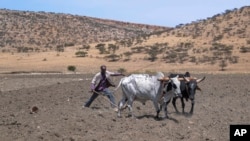The harsh realities of war and drought seem to have merged for Tinsu Shiluf, a widow living deep in Ethiopia’s Tigray region where she is raising four children after her sister recently gave birth to a child.
Two years of war between federal and regional troops killed one of her own sons, and the rest are now adults. Now, drought in the area has caused food shortages, leaving the youngest child she was raising malnourished.
She tried to find seeds among the scarce green plants in the desert’s yellow rocky landscape. But she recently traveled to Finawa Health Center near southeastern Tigray to try to save the life of her one-year-old baby.
“When we were hungry, we would eat anything in the desert,” she said. “Otherwise, nothing.”
Along with several other mothers, she sought help at a center in the remote administrative district of Nebarkhadenet. A mother of five complained that she was not breastfeeding her eight-month-old baby. Another woman, who has one-year-old twins, said she needed bags of baby food to keep “my kids alive”.
Tigray is now at peace, but the effects of the war remain, exacerbated by drought and a degree of aid mismanagement that led the United Nations and the United States to temporarily halt aid last year.
The once lush fields are now barren. Mothers’ faces were filled with worry as they watched helplessly as their children became weak from malnutrition. Nearly 400 people died of hunger in Tigray and the neighboring Amhara region in the six months to January, the national monitor revealed in January, a rare acknowledgment of hunger-related deaths by the federal government.
Most of the deaths occurred in Tigray, a country of 5.5 million people.
Until a peace deal was signed in November 2022, the region had been the scene of deadly fighting between federal troops and troops loyal to the region’s now-ousted ruling party. But months after the conflict ended, the United Nations and the United States halted food aid to Tigray as Ethiopian officials carried out a plan to steal humanitarian food on a massive scale.
Then came a deficient growing season.
Ongoing insecurity meant that only 49% of Tigray’s farmland was seeded during last year’s main planting season, according to assessments by U.N. agencies, nongovernmental organizations and regional authorities reviewed by The Associated Press. Due to drought, crop yields in these areas are only 37% of the expected total. The assessment said the proportion was as low as 2% in some areas.
The poor harvest prompted Tigray authorities to warn of an “emerging famine” that could rival the May 1984 famine that killed several people in northern Ethiopia if aid was not scaled up. One hundred thousand people died. Food was delivered to Tigray late last year, but only a small proportion of Tigray’s poor people received food aid, humanitarian workers said.
Finarwa, a farming community of about 13,000 people, was one of the hardest-hit areas.
The town’s health center still retains equipment damaged by the war, and some rooms appear to have been abandoned. Tadesse Mehari, the clinic’s director, said a lack of food in the community had forced children to flee and beg in nearby towns.
“There is nothing to eat here. So, in order to get food and save lives, they are displaced and stay away from here,” he said. “So, in this area, a lot of people are suffering. They’re starving. They’re dying from lack of food.”
Some local leaders feel helpless and have been rejecting their own people
Hayale Gebrekedian, who has been leader of the Nebar Hadnet district for five years, listened to the demands of villagers who flocked to his office on a recent afternoon. One widow, Serawit Wolde, who had 10 children, burst into tears as she recounted how five of her children had become sick from hunger.
“Please help,” she told Hayer.
Hayal told the woman he had nothing to give. “There wasn’t any (food) at all,” he said.
Khayal later told The Associated Press, “This place used to be a source of hope, even for those displaced by the war. We had enough for everyone, but now we can’t even feed ourselves.”
“The war took away everything,” he said. Nothing is left. “
Haval said access to water is another challenge. Of the 25 wells that once sustained the community and its animals, only five are still functional. People now have to travel for more than an hour and a half to get water, he said.
Drought in the region has resulted in some areas that normally receive around 60 days of rain during the rainy season receiving only very little rain.
Some farmers are not giving up.
Haile Gebre Kirstos, 70, said he continued to plow dry land and grow sorghum in a village in Mesebo, despite “only two days of rain last season.”
The land that was once lush and lush with livestock is now a barren landscape, but even after the last harvest failed, he remains hopeful.
Although plowing usually doesn’t begin until the rainy season in May or June, this year, he started work early due to urgent necessity. He spoke of farmers selling their cattle and farm equipment to support their families.
For him, the memory of the famine of the 1980s is still fresh. “It affected the entire region at the time,” he said. “Now, in some areas, things are either as bad as they were in the 1980s or even worse.”
Follow us on Google news ,Twitter , and Join Whatsapp Group of thelocalreport.in


















